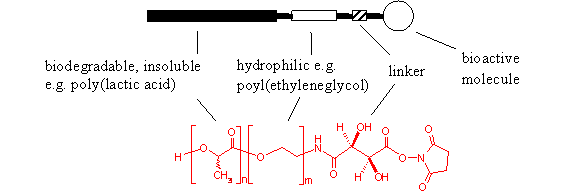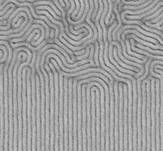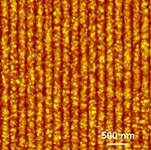
Department of Pharmaceutical Technology, University of Regensburg, Univesitätsstrasse 31, D-93040 Regensburg, Germany.
E-mail:achim.goepferich (chemi.uni-regensburg.de)
Biomimetic polymers communicate with a biological environment by interaction via bioactive molecules in or on the polymer backbone. Such materials offer significant advantages when applied in a biological environment. Thus they facilitate interactions of the material with cells and in colloidal form they hold great potential for better cellular uptake and intracellular transport. In recent years we have developed biodegradable block copolymers for the use in tissue engineering applications (FIG. 1) which give us better control over cell adhesion and cell differentiation.
Unfortunately, these materials are sometimes cumbersome to investigate, as they are subject to continuous changes such as polymer swelling or polymer degradation. One of their key features, the suppression of protein adsorption for example, cannot straightforwardly be investigated. Therefore, we studied the interaction of isolated PEG chains with proteins. For this purpose, we derivatized PEG with alkanethiols and immobilized the resulting amphiphilic molecules on gold surfaces. This allowed us to investigate the organization of PEG in the surface using atomic force microscopy. Furthermore the dynamics of protein adsorption could be determined by following the kinetics using quartz crystal microbalance techniques. These and other methods give precious insight into the properties of PEG in our polymers and the functionality of our materials.

FIG. 1: Schematic structure of biodegradable biomimetic polymer consisting of poly(lactic acid) (PLA) and poly(ethyleneglycole) (PEG).
Casali Institute of Applied Chemistry, The Hebrew University of Jerusalem, 91904 Jerusalem, Israel. danielc (vms.huji.ac.il)
The "reverse thermo-responsive" phenomenon constitutes one of the most promising strategies for the development of injectable, in vivo generated biomedical systems. The water solutions of these materials display low viscosity at ambient temperature and exhibit a sharp viscosity increase as temperature rises within a very narrow temperature interval, producing a gel at body temperature. Unfortunately, despite of their potential, some fundamental aspects of their performance severely restrict their clinical use.
This paper describes a family of novel reverse thermo-responsive polymers exhibiting much improved properties, produced by the copolymerization of poly(ethylene oxide) and poly(propylene oxide) segments using various chain extenders. These amphiphilic polymers were synthesized by covalently binding basic repeating units and by tailoring the spatial array and molecular mobility of its components. These materials were characterized both compositionally as well as structurally. Easily syringeable reverse thermo-responsive polymers that rapidly crosslink under clinically acceptable conditions, as well as multi-component RTG-displaying systems, will also be introduced.
Special efforts were devoted to create the material basis required to forward the "in situ-generated implants" strategy, which aims at engineering biomedical structures at their site of performance.
Dpt. Física de la Materia Condensada. E.T.S.I.I. Paseo del Cauce s/n. Universidad de Valladolid. 47011-Valladolid, Spain. e-mail: jreguera (eis.uva.es)
Genetic engineering techniques were used to design and biosynthesize an extracellular matrix ("ECM") analogue. This was designed with a well-defined molecular architecture comprising different functional domains (Fig. 1). The structural base is an elastin-derived repeating unit, which confers an adequate elastic characteristic. Some of these elastin domains have been modified to contain lysine; this amino acid can be used for crosslinking purposes. The polymer also contains periodically spaced fibronectin CS5 domains enclosing the well-known cell attachment sequence REDV. Finally, the polymer has target sequences for proteolitic action. These sequences are those found in the natural elastin and are introduced to help in the bioabsorption of the polymer. In addition, these proteolitic sequences were chosen in a way that, after proteolitic action, the released fragments will be bioactive. These fragments are expected to promote cell proliferation activity, angiogenesis and other bioactivities of interest for tissue growing, repairing and healing.
After purification, the resulting polymers proved to be of high purity and correct sequence. Glutaraldehyde has shown to be a cross-linking agent for this polymer, yielding insoluble hydrogel matrices. This work is framed in a long term project aimed to exploit the power of genetic engineering for the design and bioproduction of complex ECM analogues showing the rich complexity and multi (bio)functionality of the natural matrix.

Fig 1. Schematic representation of the polymer architecture, identifying each building block with its corresponding amino-acid sequence.
1. A. Girotti, J. Reguera, J.C. Rodríguez-Cabello, F.J. Arias, M. Alonso, A.M. Testera J Mater Sci-Mater M. 2004, 15, 479-484.
Department of Chemical and Biosystem Sciences and Techologies and C.R.I.S.M.A., University of Siena, Via Aldo Moro n. 2, 53100 Siena, Italy
The paradigm of tissue material interaction, which holds that protein adsorption is the first event following contact and determines that later interactions of cells, is also central to design new strategies for biocompability and tissue engineering.
A photolithographic procedure was used to create layers of hyaluronic acid (Hyal) and its sulphated derivatives (HyalS) covalently bound to Fibronectin (Fn) and Fibrinogen (Fbg). Fn plays a key role in cell adhesion while Fibrinogen (Fbg) is very important in modulating platelet adhesion and activation.
ATR FT-IR analysis demonstrated that proteins adsorbed or bonded to Hyal and HyalS had a conformation different from that of native Fn and Fbg. AFM and SEM analysis showed a completely different morphology of the analyzed surfaces when the protein (Fn or Fbg) was adsorbed or covalently bound to the polysaccharide layer despite of its chemistry (Hyal or HyalS). The analysis of cells and platelets adhesion showed that: a) human fibroblasts preferentially adhered to the Fn containing materials instead of those without protein; b) there is no platelet adhered on polysaccharides with adsorbed Fbg, while surfaces containing Fb bonded were characterized by the presence of a thick layer of adhered and aggregated platelets.
ACKNOWLEDGMENTS
The authors thank the Ministry of Education, University and Research, FIRB Programme 2001, for the financial support.
1Institute of Macromolecular Chemistry, Academy of Sciences of the Czech Republic, Heyrovsky Sq.2, 162 06 Prague, CR; 2 Center for Cell Therapy and Tissue Repair, 2nd Faculty of Medicine, Charles University, Prague, CR; 3 Institute of Physiology, Academy of Sciences of the Czech Republic, Videnska 1084, Prague, CR. E-mail: rypacek (imc.cas.cz)
Biomimetic surfaces of biomaterials, designed to control mammalian cell behavior and guide the formation of organ specific tissues, have recently become an attractive area of tissue engineering. The bioactivity is introduced through tethering extracellular matrix (ECM) components e.g. fibronectin, laminin or their active fragments to the material surface. The biomimetic surfaces provide solid-state signals to the seeded cells and thereby control cell activities.
The presented work uses block copolymers composed of hydrophobic polyester block, hydrophilic poly(ethylene oxide) (PEO) block and a bioactive ligand, to modify surface of polyester-based biomaterials.Functional polymer surfaces with controlled distribution of adhesion structures have been prepared through surface deposition of functional block copolymers using various strategies. Vascular smooth-muscle and endothelial cells were used in cell cultivation studies to evaluate the effect of surface modifications on cell adhesion and growth on polymer films. Thus, functional amphiphilic block copolymers can be used as a versatile modular system providing for different types of bioactive, patterned surfaces of polymer biomaterials, exhibiting selective interactions at biomaterial-cell interfaces.
The financial support of Grant agency of ASCR (A4050202) and of Ministry of Education of CR program of research centers (LN00A056) is acknowledged.
aCharlesUniversity, 1st Faculty of Medicine, Institute of Anatomy, U nemocnice 3, CZ-128 00 Praha 2, Czech Republic
bCharlesUniversity, 2nd Faculty of Medicine, Center of Cell Therapy and Tissue Repair, V Úvalu 84, CZ-150 06 Praha 5, Czech Republic
cInstituteof Macromolecular Chemistry, Academy of Sciences of the Czech Republic, Heyrovského nám. 2, CZ-162 06 Praha 6, Czech Republic
dCharlesUniversity, 3rd Faculty of Medicine, Department of Burn Surgery, Šrobárova 50, CZ-100 34 Prague 10, Czech Republic
Skin defects of both the traumatic and trophic nature represent the important medical, social and economical problem. Although the several commercial technologies are available, the efficiency of therapy is not always sufficient at large clinical scale. In light of these data, the devices prepared by tissue engineering methods can represent new horizons how to treat these disorders. The development of new technologies require to improve the knowledge about the biology of epidermal stem cells that are necessary to isolate effectively the pool of stem cells and expand these cells in vitro. The knowledge about the mechanisms controlling the differentiation of these stem cells under in vitro condition are also not sufficient to produce defined keratinocyte population at large scale for efficient cell therapy of wounded skin. The previous data demonstrated that grafting of keratinocytes at stage of subconfluent monolayer is highly effective in comparison with multilayered structures with problematic support of grafted cells with nutritives and oxygen, which decreases the viability of graft and efficiency of therapy. The polymer support can be treated by immobilisation of bioactive substances participating in the control of cultured cell behaviour. Use of these types of polymers for cultivation of keratinocytes can increase the efficiency of application of epidermal cells in cell therapy of skin defects. In summary, the development of new devices for treatment skin defects needs the cooperation of clinicians with polymer chemists, cell and molecular biologists to prepare safe procedure for the care of skin disorder at clinical scale.
The presented results were supported by Grant Agency of the Czech Republic project No. 304/04/0171, by Academy of Sciences of the Czech Republic, project No. S4050005 and by Ministry of Education, Youth and Sport of the Czech republic, projects No. LN00A065 and MSM111100005.
Department of Materials Engineering and Industrial Technologies University of Trento, via Mesiano 77, Trento, Italy
Recent work has proved that silk fibroin, i.e. one of the two proteins composing the silk filament, is a material suitable for the fabrication of scaffolds for tissue engineering applications. It has been demonstrated, in fact, that fibroin is able to promote cell adhesion and proliferation.
Starting from the silkworm filament, fibroin can be processed by different methods, in order to obtain fibroin films, nets, foams and gels that could be employed for a variety of applications and biological needs. High water content fibroin gels can be produced starting from fibroin-water solutions by adding acids, alcohols or even by thermal treatments. Some gel formulations are injectable, so having clear advantages for specific applications due to the possibility of implanting them through minimally surgically invasive protocols.
Gel formation occurs through conformational changes that impart fibroin molecules a b-structure and create water insoluble so-called silk II crystalline domains. In rheological and dynamic mechanical tests gels displayed a linear viscoelastic behaviour with values of moduli that depend on the preparation method. Also morphologies change, revealing, for instance, a compact and homogeneous structure for gels prepared by adding alcohol (i.e. glycerol) or uniformly porous for citric acid addition induced gels.
This lecture will present some methods of fibroin gel fabrication, their physical properties and some preliminary in vivo and in vitro tests results.
Laboratory for Micro and Nanotechnology, Paul Scherrer Institut, 5232 Villigen PSI, Switzerland
Lithography processes used in micro and nano-fabrication rely on the selective dissolution of polymer based materials exposed by optical or particle beams. In a typical lithographic fabrication process a polymer film is exposed to a beam that renders the polymer either soluble or insoluble in a developer solution. The resulting structured polymer film is then used to transfer the pattern into the material of interest, e.g. a metallic, dielectric or semiconductor layer. This approach has served the microelectronics industry especially well. The continued miniaturization in microelectronics and the spread of the lithographic fabrication approach to other areas such as the production of biological and chemical devices bring about new challenges and opportunities in the way polymers are used to make miniature parts.
We have recently developed several alternative approaches to the creation of nanometre scale patterns in polymer films. The common thread in these techniques is the formation of a chemical pattern on the substrate surface which is then used to influence the deposition of a polymer film. We applied this approach to the alignment of block copolymer domains on surfaces coated with self assembled monolayers (Fig 1(a)) and to the selective grafting of polymers on spatially defined regions (Fig. 1(b)). In both cases the substrates were exposed with x-ray interference lithography to create the necessary chemical modifications. Examples of the advantages include specific interaction (e.g. bonding) between the substrate and the polymer film, thermodynamic control of morphology at the molecular length-scale, and combination of structural and chemical functionality in the polymer pattern.
| (a) |  |
(b) |  |
Fig. 1 (a) Lamellar block copolymer domains aligned by the chemically patterned template (S. O. Kim, et al., Nature 424, 411 (2003)) (b) Poly acrylic acid lines grafted on an ETFE substrate with spatially defined radicals. (H.-P. Brack et al., J. Am. Chem. Soc. 126, 1004 (2004))
Faculty of Chemical and Food Technology, Slovak University of Technology in Bratislava, Radlinskeho 9, SK- 812 37 Bratislava, Slovak Republic
Polyelectrolyte complexes based on natural polymers are formed by reaction of oppositely charged polymers containing covalently bound either anionic (polyanions) or cationic (polycations) groups. They represent an attractive class of polymer-based materials finding an irreplaceable role in many areas of the everyday life used for preparation of biodegradable and biocompatible 3D membranes, (micro) capsules and various types of controlled release devices. These membranes are effectively used as scaffolds in tissue engineering for a replacement connective tissue. The necessity to consider each of these areas of polymer chemistry becomes important in designing the ultimate properties of the polyelectrolyte complex stemming from the complexity of polyelectrolytes and process of the complex formation. Numerous factors affect the properties of the polyelectrolyte complex placing the stringent requirements on the selected polyelectrolytes as well as on the preparation conditions. From the point of view of polymer hydrogels, the polyelectrolyte complexes belong to the category of the physically crosslinked gels with the crosslinks of small but finite energy and/or of finite lifetime. Usually, chemical crosslinking has been widely used to increase the mechanical and biological stability of biomaterials.
Chitosanand some of its derivatives and complexes have been studied for use in biomedical applications, include tissue engineering. Especially, the biomaterials based on complexes associating chitosan and glycosaminoglycans (also together with collagen) can be taken into consideration for improving the wound-healing acceleration and cellular assistance for skin and cartilage recovery. The gel complex formation depends on conditions favourable to polyanion interactions held among components. Due to a complexity, such study has been focused on optimisation and properties testing of the membrane based on polyelectrolytes complex chemically modified with starch dialdehyde derivatives. The products being developed should satisfy several requirements as is good adhesion and cell growth, reproducibility in their three dimensions, large surface area for cell-polymer interactions, mechanical properties, cytotoxicity, and biodegradability.
Institute of Polymer Research Dresden & The Max Bergmann Center of Biomaterials Dresden, Hohe Str. 6, 01069 Dresden, Germany
A platform of thin polymer coatings was introduced for the functional modulation of immobilized bioactive molecules at solid/liquid interfaces. The approach is based on covalently attached alternating maleic acid anhydride copolymers with a variety of comonomers and extended through conversion of the anhydride moieties by hydrolysis, reaction with functional amines, and other conversions of the anhydride moieties. We demonstrate that these options permit control of the physicochemical constraints for bioactive molecules immobilized at interfaces to influence important performance characteristics of biofunctionalized materials for medical devices and molecular diagnostics. The copolymer thin films were thoroughly characterized with respect to reactivity, elemental composition, hydrophobicity, morphology and electrical charging.
The resulting variety of chemical and physical characteristics of the coatings was found to be most valuable for the well-defined immobilization of proteins of the extracellular matrix, growth factors and biomimetic coagulation inhibitor molecules at interfaces using a broad range of distinct binding principles. Examples concern the impact of the substrate-anchorage of fibronectin on the formation of cell-matrix adhesions, the differentiation of endothelial cells into capillary-networks and the orientation of endothelial cells according to lateral anti-adhesive micro-patterns using grafted polyethylene glycols, and the spacer-dependent activity of immobilized synthetic thrombin inhibitors.
State Key Laboratory of Polymer Physics and Chemistry, Changchun Institute of Applied Chemistry, Chinese Academy of Sciences, Changchun 130022, P. R. China
A biodegradable amphiphilic triblock copolymer of poly(ethylene glycol)-b-poly(L-lactide)-b-poly(benzyl-L-glutamic acid) (PEG-b-PLLA-b-PBLG) was synthesized by the ring-opening polymerization of N-carboxyanhydride of -benzyl-L-glutamate (BLG-NCA) with amino-terminated MPEG-b-PLLA-NH2 as a macroinitiator. MPEG-b-PLLA-NH2 converted from MPEG-b-PLLA-OH first reacted with tert-Butoxycarbonyl-L-phenylalanine (Phe-NBOC) and dicyclohexylcarbodiimide (DCC) and then deprotected the tert-butoxycarbonyl group. MPEG-b-PLLA-OH was prepared by ROP of L-lactide with mnomthoxy poly(methylene glycol) in the presence of stannous octoate. The structures of the trblock copolymer and its diblock precursors were confirmed by 1H NMR, FTIR and GPC measurements.
A novel amphiphilic biodegradable cationic hyperbranched block copolymer poly(ethylene glycol)-polyethylenimine-poly(γ-benzyl L-glutamate) (PEG-PEI-PBLG) was successfully synthesized by ring-opening polymerization (ROP) of N-carboxyanhydride of γ-benzyl-L-glutamate (BLG-NCA) with PEG-PEI as a macroinitiator. PEG-PEI was firstly prepared by coupling of PEG and PEI using hexamethylenediisocyanate (HMDI). 1H NMR, GPC, and TGA were used to characterize the PEG-PEI-PBLG copolymers. PEG-PEI-PBLG copolymers were found to be self-assembled in water with CMC in the range of 0.00368-0.0125g/l and high hydrophobic micelle core. The micelle size and critical micelle concentration (CMC) were depended on the hydrophobic block content and the ionic state of the PEI block. The CMC decreased with the increase of the PBLG block content. The micelle size decreased while CMC increased in the protonated degree of PEI block. An interesting complex coacervation was found between hyperbranched PEG-PEI-PBLG copolymer and bovine serum albumin (BSA) in aqueous solution. SEM micrographs showed that the complexes had a uniform spherical shape with average diameter about 0.8-1.2μm. This copolymer could be potential as a candidate for drug and gene delivery.